
Cockenzie in the late 1990s with Ian McMillan, a former manager at Weatherhead & Sons, on the left.
The original slipway can just be seen behind.
Shipbuilding - Weatherhead & Sons, Cockenzie
Small scale shipbuilding, mainly of fishing boats, had long been carried out along the east coast of Scotland and in East Lothian as elsewhere. The small firm of William Weatherhead and Sons of Cockenzie had been established in 1880 and it had been designing and building yachts and fishing boats ever since. When the war began, the Admiralty signed contracts to build Fairmile B Class Motor Launches with shipyards and boat builders all over the UK including, in Scotland, Dickie & Sons, Tarbert, Robertson & Sons, Sandbank, James A. Silver Ltd, Dumbarton, James Miller, St Monans, Thomson & Balfour, Bo'ness and Sandy Weatherhead and his son, Willie John, in Cockenzie. Later, further contracts were signed with shipyards all over the Empire, in Canada, South Africa, Egypt, Hong Kong, India, Singapore, Zanzibar and Jamica. Amusingly, one company was named the Anglo-American Nile Tourist Company in Cairo! The war effort was global in scope.
The companies based in the Forth were responsible for constructing forty-one Fairmile MLs with James Miller's of St Monans producing the greatest number (twenty-seven).
Weatherheads constructed eighteen MLs during the war. These were:
ML 168 Ordered…… 8 Jan 1940…… Commissioned……23 Nov 1940
ML 218 Ordered…… 8 Jan 1940…… Commissioned……17 Mar 1941
ML 243 Ordered…… 8 Jan 1940…… Commissioned……26 May 1941
ML 269 Ordered…… 21 May 1940……Commissioned……28 July 1941
ML 300 Ordered…… 21 May 1940……Commissioned……30 Sept 1941
ML 455 Ordered…… 29 Apr 1941……Commissioned…… Nov 1941
ML 473 Ordered…… 29 Apr 1941……Commissioned…… 03 Feb 1942
ML 495 Ordered…… 27 Aug 1941……Commissioned……May 1942
ML 516 Ordered…… 27 Aug 1941……Commissioned……Jun 1942
ML 535 Ordered…… 28 Nov 1941……Commissioned……Aug 1942
ML 545 Ordered…… 28 Nov 1941……Commissioned……Sept 1942
ML 561 Ordered…… 28 Nov 1941……Commissioned……Nov 1942
ML 596 Ordered…… 18 May 1942……Commissioned……18 Jan 1944
ML 599 Ordered…… 18 May 1942……Commissioned……03 Apr 1944
ML 905 Ordered…… 30 Aug 1942……Commissioned……10 May 1944 LOST
ML 912 Ordered…… 30 Aug 1942……Commissioned……29 June 1944
ML 916 Ordered…… 30 Aug 1942……Commissioned……16 Sept 1944 LOST
ML 921 Ordered…… 30 Aug 1942……Commissioned……22 Nov 1944
All Weatherhead's MLs survived the war apart from ML 905 which sank on the Sitang River in Burma (Myanmar) on the 9th May 1945 and ML 916 which hit a mine and sank off Walsoorden, Netherlands, on the 8th November 1944. ML 269 was briefly loaned to the Free French Navy in 1942 and ML 561 was sold to the Greek Navy after the war. The rest were sold off after the war ended.
[I am indebted to uboat.net for this detailed information]
The task of constructing these relative large launches (large for Weatherhead's facilities) required certain changes at Cockenzie. First the small workforce of a dozen had to be doubled by employing local joiners. Second, another shed had to be built alongside the original and, third, the depth of the original slipway had to be lowered by hand to accommodate the much larger proportions of the Motor Launches.
The MLs were 112 feet (34.13 mtrs) in length and carried a crew of sixteen. They could reach speeds of twenty knots and were armed with one three pounder and two .303 Anti-Aircraft machine guns.

Model of the Fairmile B Class Motor Launch ML 912 built at Weatherhead & Sons and commissioned on the 29th June 1944
The MLs were mainly made of prefabricated parts sent up from Cobham in Surrey from the Fairmile Marine Company. Much of the marine plywood and other wooden parts had originally come from America via Lend Lease.

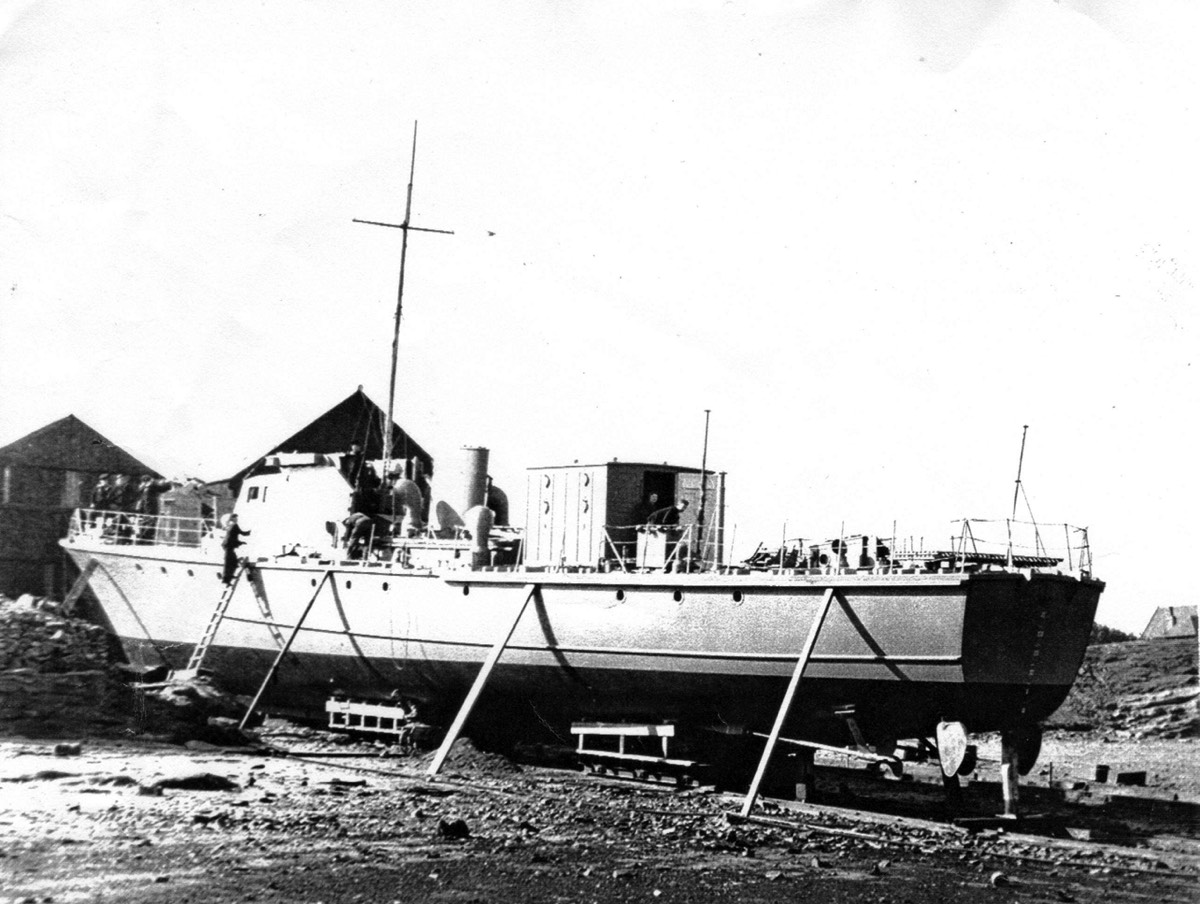
Two views of a Weatherhead built Motor Launch on the slipway at Cockenzie preparatory to its launching.
Weatherhead's and Operation Pedestal, August 1942
It could be described as tenuous but the link between Weatherhead's and this operation in the Mediterranean is, nonetheless, fascinating. Operation Pedestal was the operation designed to supply Malta with vitally needed supplies, including desperately needed aviation fuel. Considerable Allied naval forces moved into the inland sea as escort to fourteen merchant ships and the ensuing battle was ferocious, as the Axis forces did their best to prevent the ships reaching Malta. In the end, five vessels made it, including the famous SS Ohio, the only tanker available at the time. One of Weatherhead's MLs, ML 168, was part of the 3rd Motor Launch Flotilla which had reached Malta via Gibralta on 16th June 1942. Once there, it acted as a minesweeping force and as an escort for submarines moving in and out of Valetta harbour.

A Maltese stamp commemorating Operation Pedestal and the part played by Weatherhead's ML 168 and the 3rd Motor Launch Flotilla
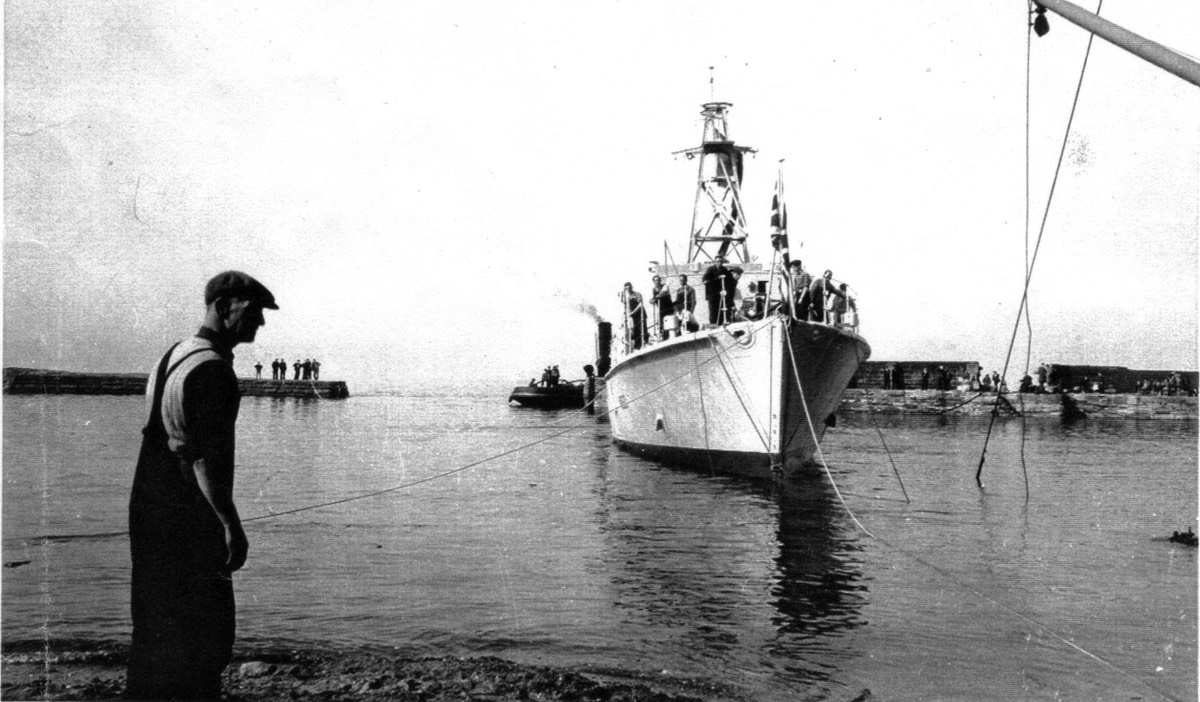
The launch of a Motor Launch at Cockenzie.
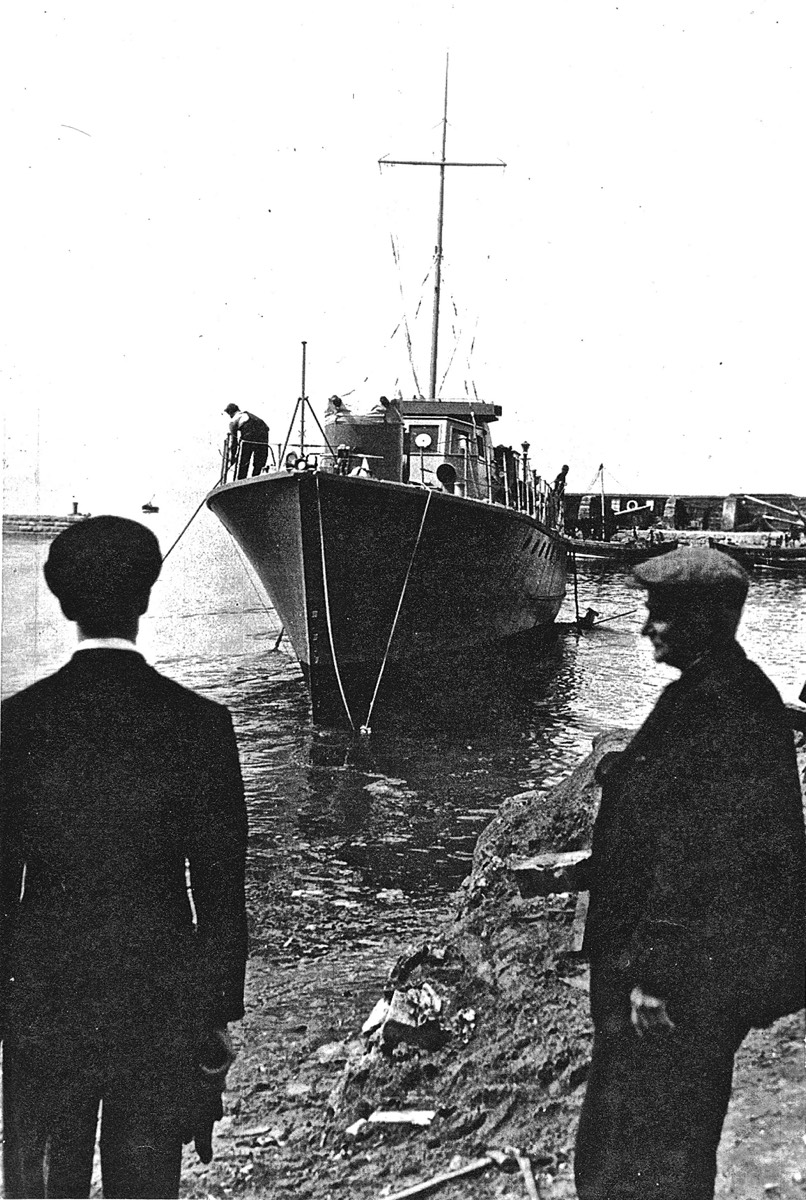
A naval officer and Mr Weatherhead (on the right) watch the launch of an ML. Is this its future captain?
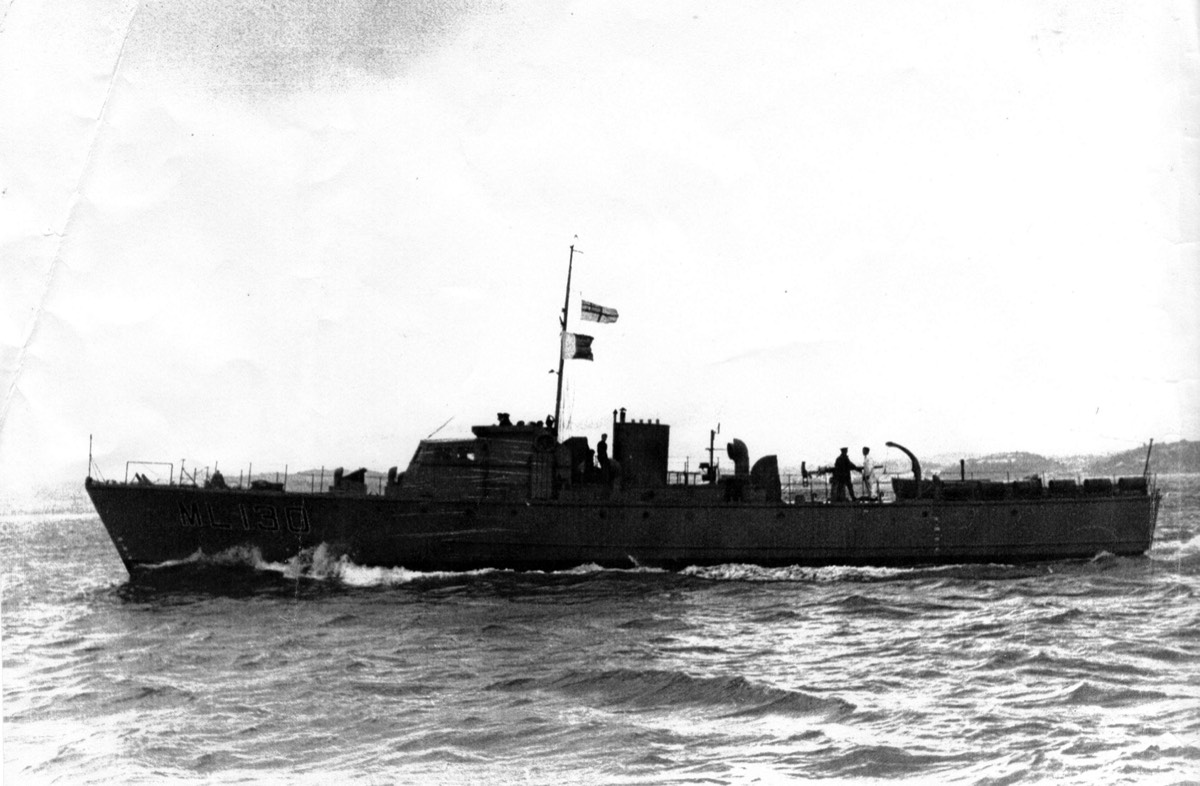
An ML, quite possibly one built at Cockenzie, on sea trials in the Forth.
Cunliffe-Owen, Aircraft repair, Macmerry

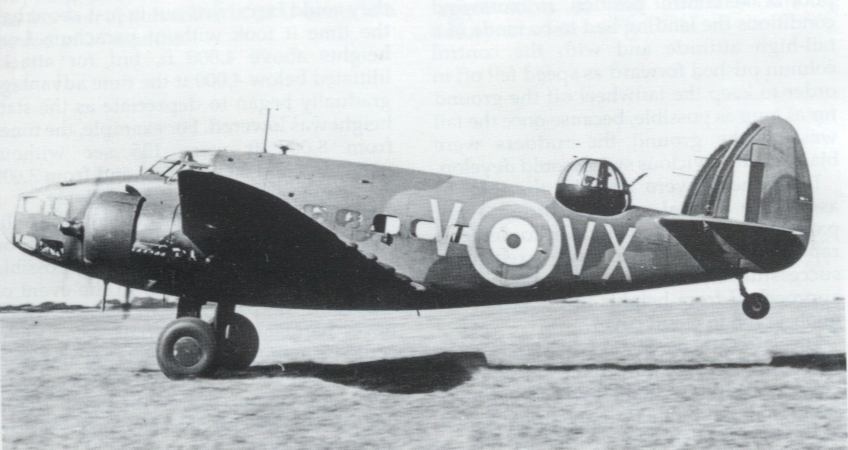
Grumman Hellcats (on the left) and a Lockheed Hudson, two of the types repaired by Cunliffe-Owen Ltd beside Macmerry airfield.
Cunliffe-Owen Ltd., Macmerry
Throughout the war years many tens of thousands of aircraft had to be built, reassembled after transportation, modified, updated or simply repaired. Many of these aircraft were recovered either by the RAF’s own Maintenance Command via a Salvage Party or by civilian workers under the direction of the Civilian Repair Organisation. Barry Abraham, who has written on the latter, believes some fifty such organisations existed throughout the UK and that some 80,000 aircraft were recovered and repaired thanks to their efforts.
The firm of Cunliffe-Owen Ltd.,was set up near Southampton airport prior to the war to build the OA-1, a version of the Burnelli Flying Wing. In 1939 it moved to a purpose-built factory adjacent to the southern boundary of Southampton/Eastleigh Airport and throughout the war it was responsible for the assembly, modification and repair of a variety of aircraft types including Hurricanes, Hudsons, Airacobras, Kittyhawks, Lancasters and Halifaxes. This was a large-scale operation and it was claimed some 6,000 aircraft were processed there throughout the war.
The danger of placing all the proverbial eggs in one basket soon became apparent when the Eastleigh factory was attacked during an air raid and, in line with other firms, Cunliffe-Owen set about establishing satellite repair facilities, for example, at Silloth near Carlisle, Thornaby, Edzell and at Wick. In pursuit of this process of dispersal, Cunliffe-Owen opened facilities built just beyond the eastern end of Macmerry aerodrome, as can be seen from the aerial photograph below.
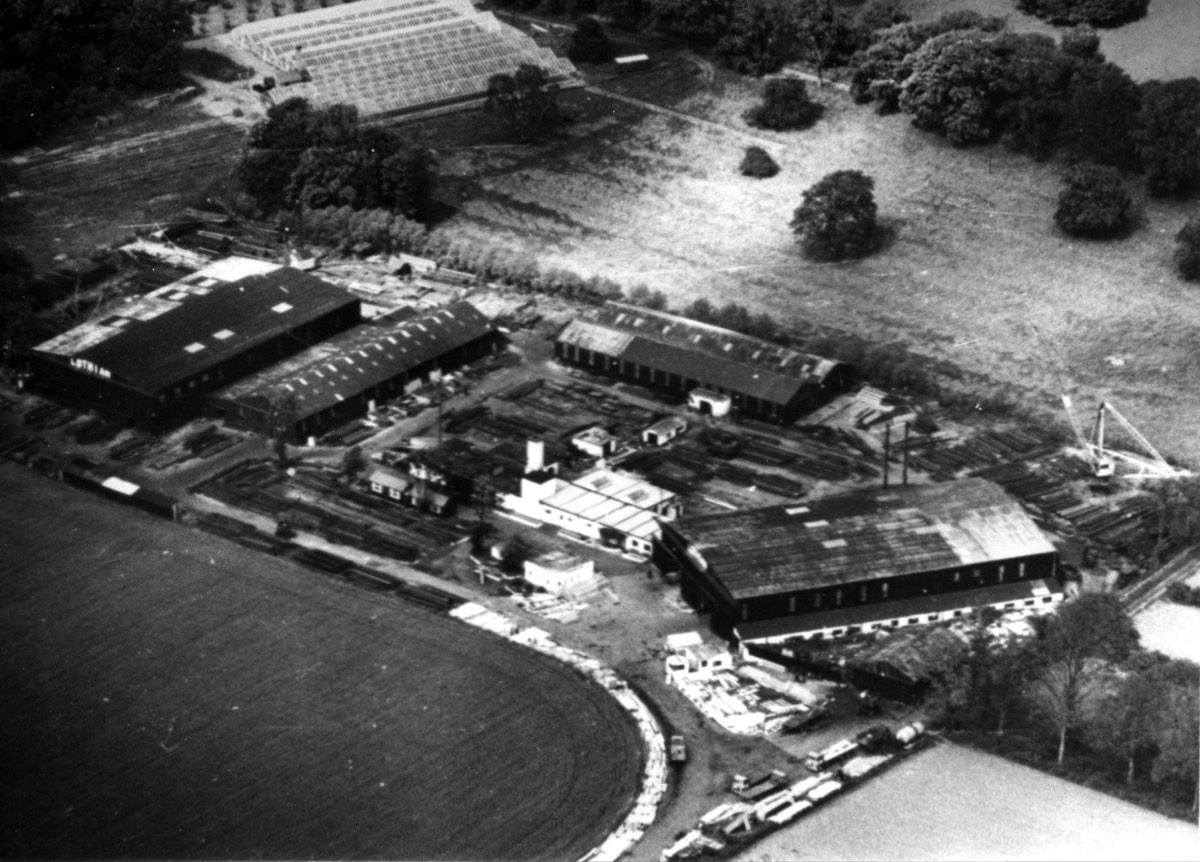
Cunliffe-Owen’s aircraft repair facility, just east of Macmerry airfield.
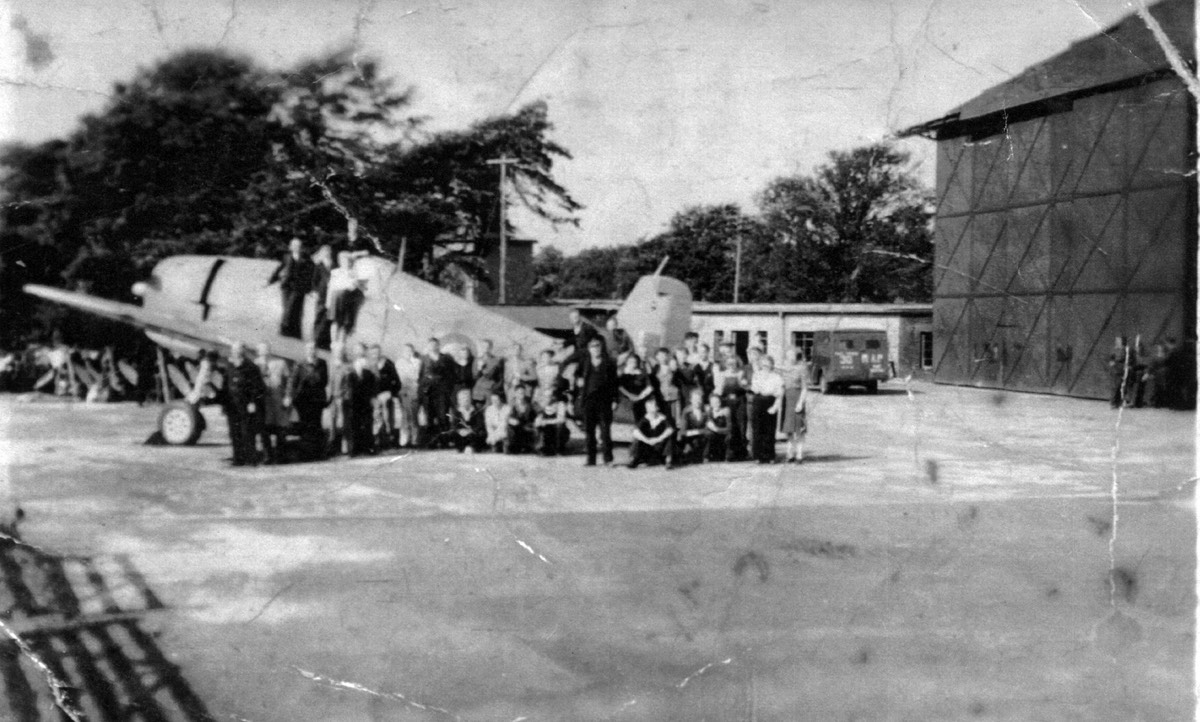
Cunliffe-Owen workers pose beside or on a Grumman Hellcat at Macmerry and beside an unidentified aircraft below.
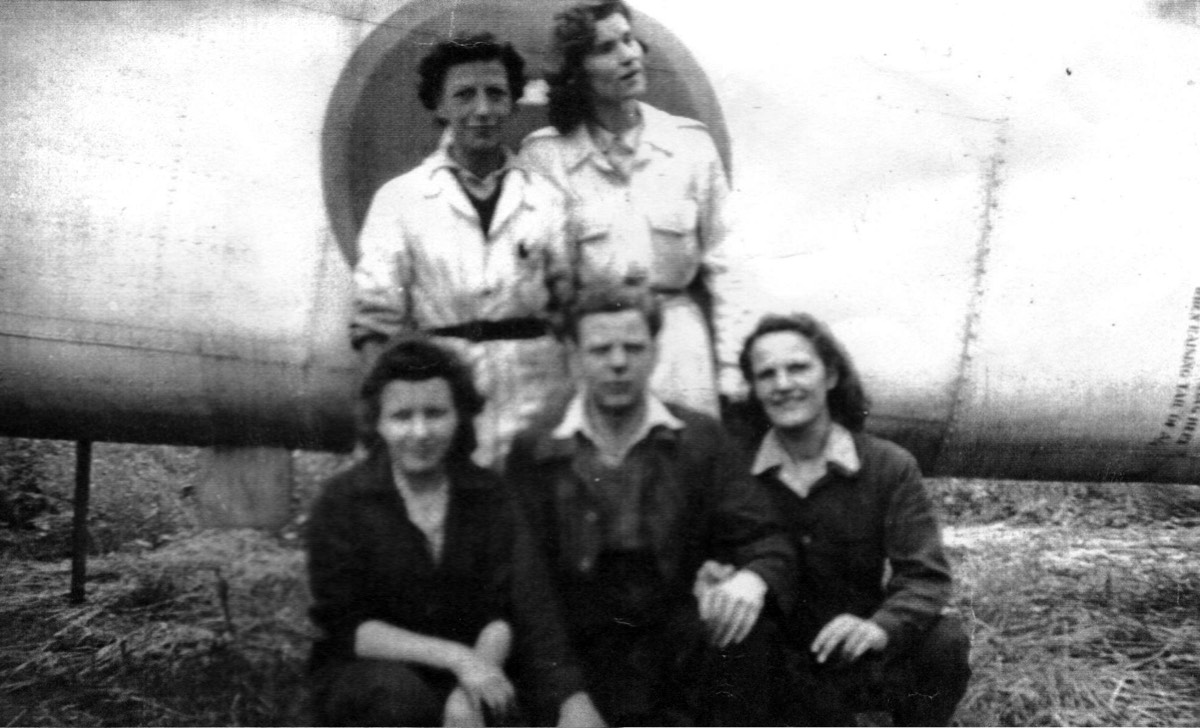
Back row: Helen Smith (Longniddry), Marion Hart (Gullane)
Front: Margaret Hume (Longniddry), unknown, Ina Rae (Tranent).
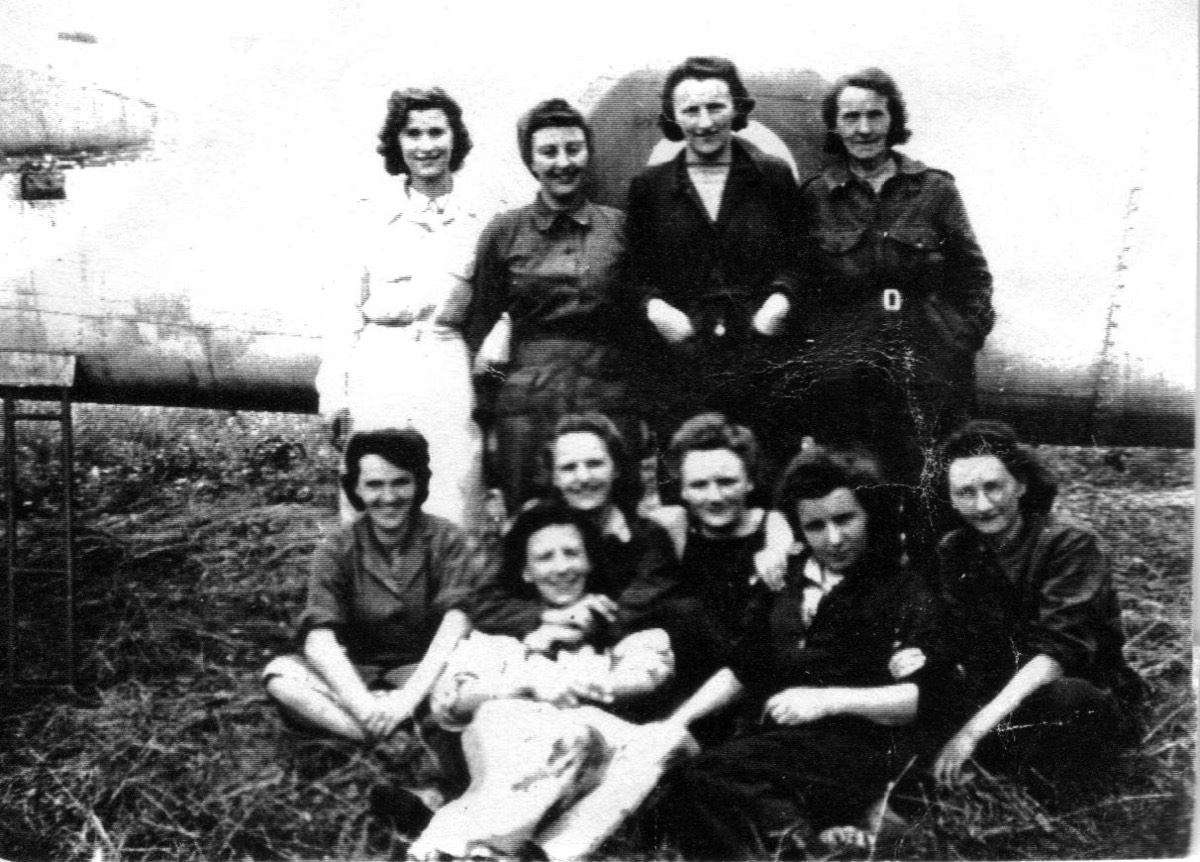
Jean Douglas has been positively identified as the lady 3rd from the left in the back row. She married and became Mrs Jean Tasker. Others in this picture should include:
Marion Hart; Mary Gray (Macmerry); Ina Rae;
Helen Smith; Helen Darling (front left); Margaret Hume; Bridget Torley (Tranent) and Mrs Gorman (Haddington)

Workers at Cunliffe Owen in front of a Fairey Swordfish.
William Smith of Elphinstone is third from the right back row. [R.K Smith]
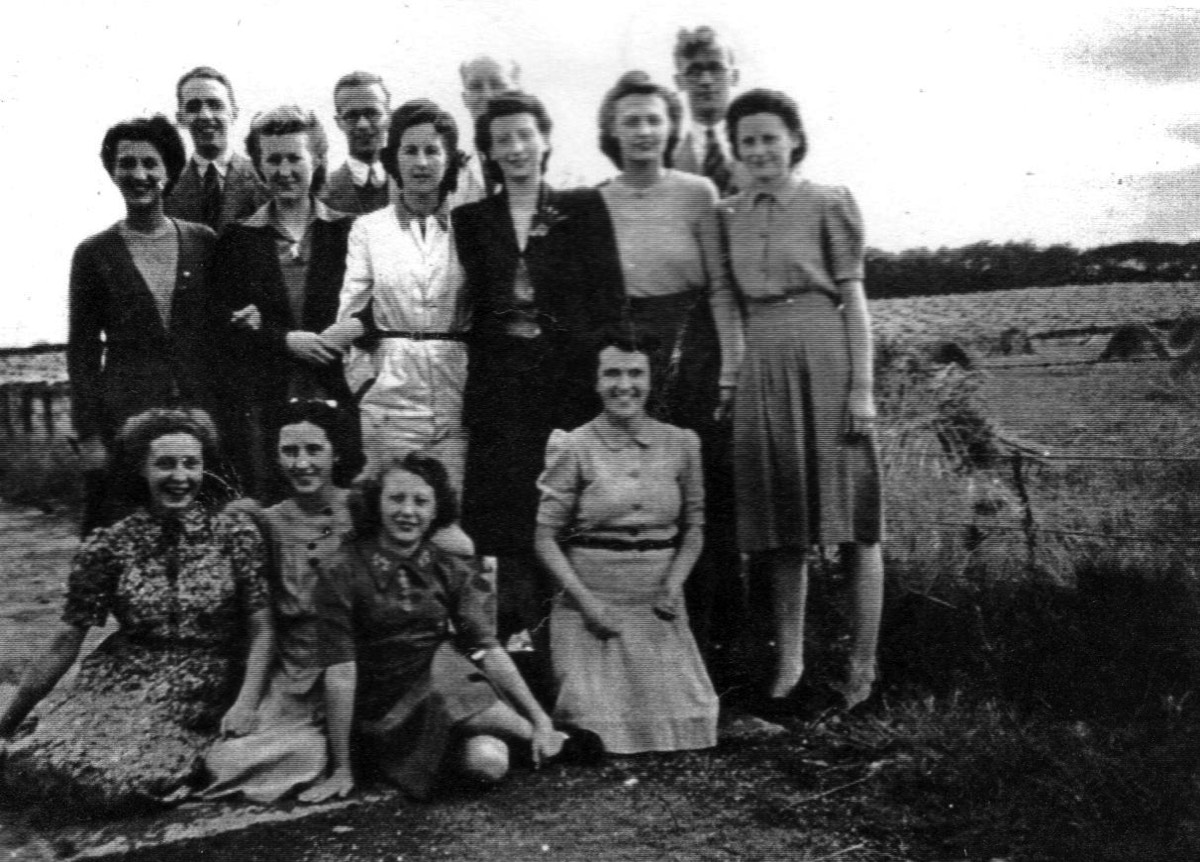
A mixed group of Cunliffe-Owen workers who were living at Gladsmuir Hall. The middle row contains Esme Thompson from Musselburgh and Jean Watt from Tranent. Helen Darling is kneeling (front right). Helen first worked in the office and then trained as a riveter working on the planes. She met Eric Cole at the unit and married him in 1945. They stayed at Letham Mains, Haddington. Eric had been working in Southampton before he was transferred to Macmerry. [thanks to Mary Bowman (née Cole) Helen's daughter.]
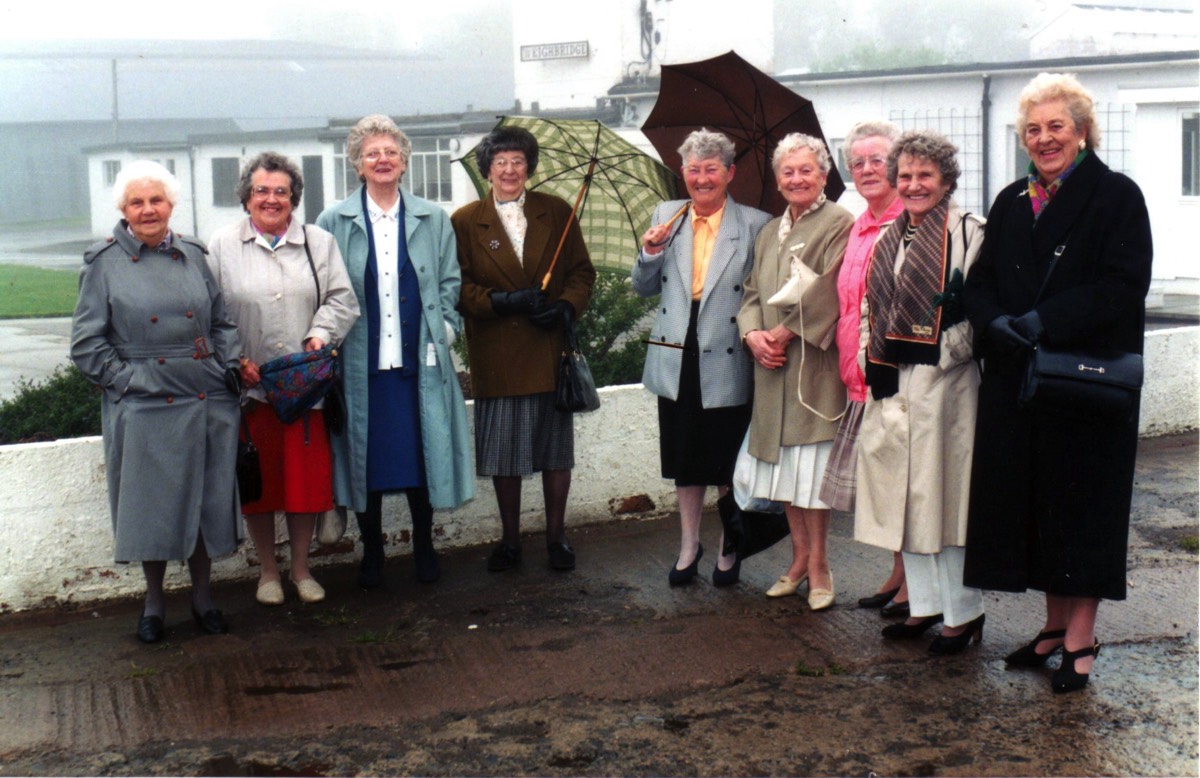
Several of the ladies shown in the wartime photos above returned to Macmerry to be interviewed on site on a misty morning in March 1997. Helen Cole (née Darling) is standing second from the left. Her great friend, Beatrice Fulton from Tranent, is standing with the brown umbrella. She later owned a wallpaper shop in Tranent.
Can you help identify the others?

It wasn’t all work and no play at Cunliffe-Owen’s. This cartoon was drawn by
a member of the firm’s drawing office, a Rob Illiard or Hilliard.
Bruntons Wire Mill, Musselburgh
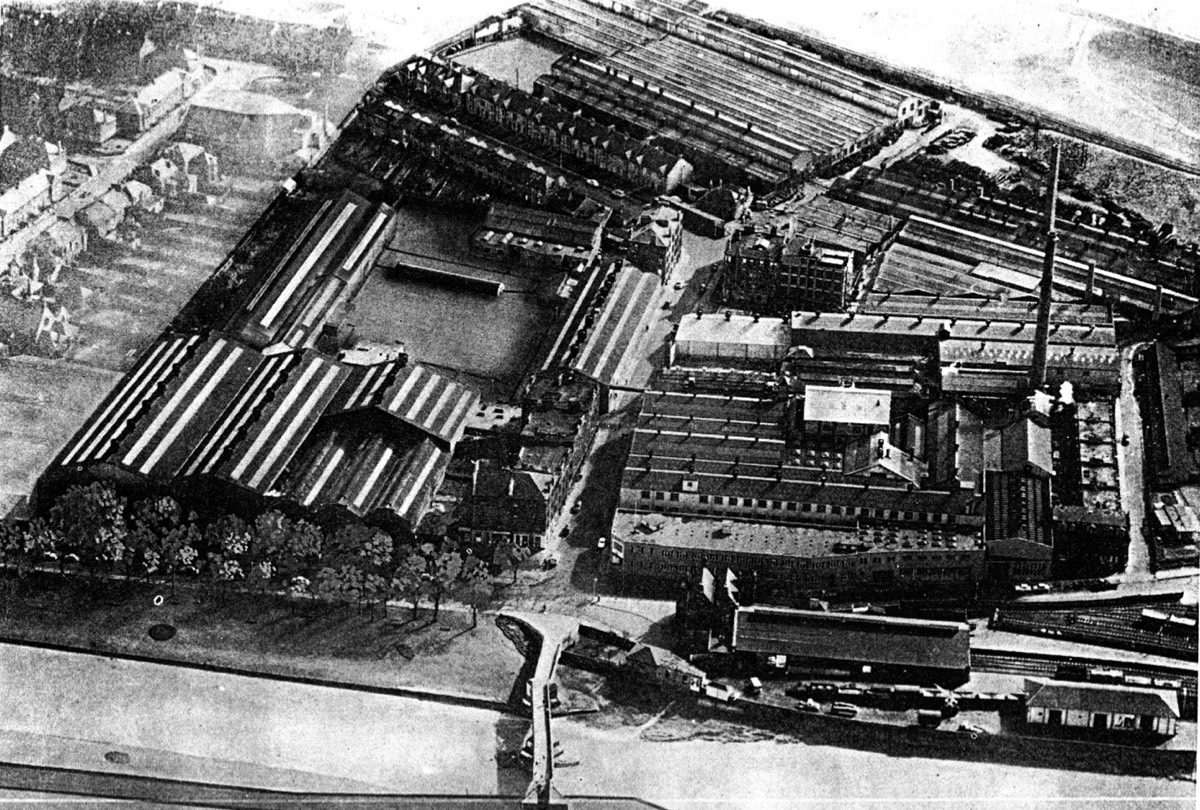
Bruntons (Musselburgh) Ltd. Wire Mills, after the war.
The War Years
Bruntons wire products were in very high demand during the war years and, fortunately, the firm’s management had been sufficiently far-sighted to have prepared the way for increased and increasingly diverse production prior to 1939. The new machines and production facilities , e.g. a new ropery, new Standing and Closing machines, a new Cold Rolled Strip Department and even new offices had all been put in place before the war.
The demands for increased production resulted in the employment of more women and an increased number of unskilled men. This did lead to some pay disputes and union involvement but such disputes were settled as quickly as possible. The basic matters of the provision of blackout curtains and the construction of air raid shelters were first on the list as was the fitting of a steam siren onto the firm’s boilers. On the first occasion that this should have been activated a rather deaf employee ensured it wasn’t!
Efforts to establish a Shadow factory elsewhere in Scotland to produce Aero engine Valve Spring wire came to naught and the Spring wires were produced at Musselburgh instead. The list of products was long. Bruntons manufactured aircraft control wires, bomb slings, aero cable fittings, whip aerials, ropes for all purposes (including the steel cables for barrage balloons), anti-submarine nets and the fine wires for the PIAT anti-tank gun.
As you can see below, the workforce provided the men needed to form a Home Guard unit and the workers in the canteen could listen to the likes of Noel Coward and a variety of ENSA performers during their short periods of free time.
[I’m grateful to Alastair Adam whose book ‘Bruntons 1876-1962’ formed the basis of this section on Bruntons].

Musselburgh Home Guard on parade including many Bruntons men.
The officer in front may be Captain Corbett.

A group of men of the 7th Battalion (Musselburgh) Home Guard (c1941) in the garden of a house in New Street, the upper window of which was used as an observation post giving a view of the Forth. Lanyon (Lanny) Nicholson is second from the left. He worked in the Mall Park section of Bruntons.
Can you identify the others?
Eye Witness - Donald Manson
Donald lived all his days in Musselburgh and started work at Bruntons in 1934. He worked there for fifty-one years and started in their Sea Mill factory. This was transferred to Mall Park (near the present Tesco supermarket) although locals often still referred to it as the Sea Mill. Donald was in the Territorial Army at Prestonpans where the TA had its Drill Hall. The latter is now the Prestonpans Labour Club. Donald joined the Royal Artillery and served in France. He retreated from Rennes, avoided Dunkirk and got home from St. Malo via a fishing boat carrying a load of flowers! Because he was a tool-maker to trade and this was a reserved occupation, he went back to work at Bruntons. Donald joined Bruntons Home Guard unit and, because he had been in the army, he was made a Sergeant. He remembers one incident when all the platoon was put onto a boat at Morrison’s Haven and then proceeded to ‘attack’ Musselburgh. Donald described how Bruntons had six mills, each manufacturing its own specialist product: wire; rope, nets, etc., from steel bought in from outside steel mills. The firm made wire as thin as 1/1,000 of an inch and much of the firm’s wires went into aircraft.
Bruntons worked twenty-four hours a day and had its own canteen for dances and shows. Some of the shows were brought down from places like the Theatre Royal in Edinburgh (long since burnt down). The canteen was run by Mrs Salvesen of the famous shipping company. Donald remembers two incidents from the war: the first occurred when Handley Page bombers got lost and landed on the beach near Musselburgh, worked out where they were and then took off again. He also remembered when, on January 1st, 1941, a train, travelling up from the south, was misdirected by points which hadn’t been changed and ploughed on into the buffers at Musselburgh killing a Miss or Mrs Krause, a Belgian refugee from World War One.
Bruntons still exists today, still in Musselburgh but on a smaller and different site.

